The sad demise of RMS Windsor Castle
Posted by Chris Graham on 12th April 2023
Peter Knego recalls the sad story of the former Union-Castle liner RMS Windsor Castle, and a final visit he made to the ship back in 1998.
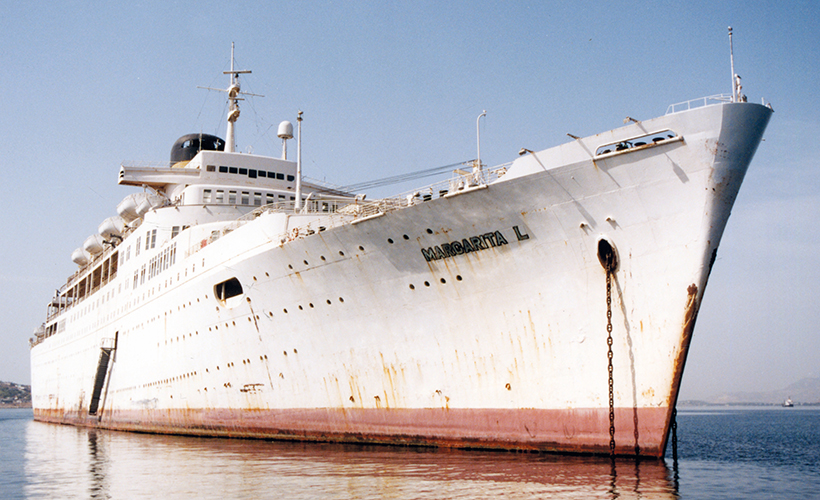
Margarita L at her lonely Petrola anchorage in 2001, a few months after Marianna 9’s departure for Indian breakers. (Pic: Peter Knego)
In the early morning of 14th December 1998 we were riding in a taxi to the port of Petrola, an industrial enclave filled with oil refineries at the northern end of the Bay of Eleusis. Once there, we boarded a private launch that took us out to Margarita L, the former Union-Castle liner RMS Windsor Castle, and my dream of gaining access to this historic vessel was finally coming true.
The ship, laid-up in the anchorage since 1991, had just been placed on the sales list after the health of her nearly 90-year-old owner, Greek billionaire John S Latsis, had begun to decline. Through the offices of a shipbroker, I was granted permission to document the ship in the hope of helping to get her sold for preservation in a static role.
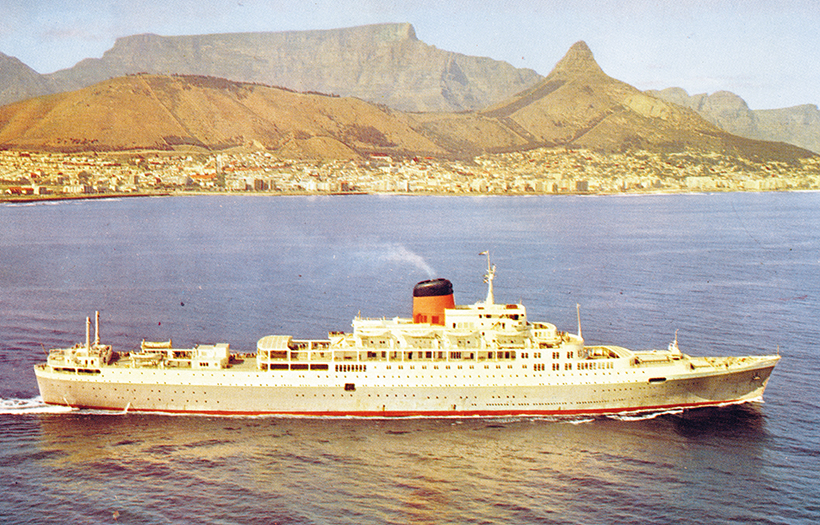
A postcard view of RMS Windsor Castle off Cape Town. (Pic: Peter Knego collection)
As we headed out to the ship, on our port side the Latsis-owned Marianna VI (ex-Aureol) and Europe (ex-DFDS England) comprised a small but fascinating raft. I asked the captain if we could circle the former Union-Castle liner before boarding. Margarita L was tied up with Marianna 9, the former Portuguese liner Principe Perfeito.
Named for Latsis’ two daughters, both ships were beginning to show signs of superficial neglect, with rust and bird droppings streaking their length, but there was no denying each exemplified classic, early 1960s British shipbuilding. The 19,393gt 1961-built Marianna 9 was constructed by Swan Hunter, Wigham Richardson on the Tyne and had a low, sleek profile, with a raked bow, domed midships funnel and terraced afterdecks.

Crowds look on as RMS Windsor Castle is launched at Cammell Laird’s shipyard at Birkenhead, on 23rd June, 1959. (Pic: Peter Knego collection)
Margarita L towered over her fleetmate and looked far larger than her size, thanks to her long, towering bow and stepped-up forward superstructure. She was built by Cammell Laird at Birkenhead and launched by HM Queen Elizabeth The Queen Mother on 23rd June, 1959. While her career with Union-Castle was painfully short, the ship was nonetheless considered one of the most glorious of any of Britain’s mid-20th century ocean liners.
Windsor Castle’s maiden voyage from Southampton to Durban commenced on 18th August, 1960. At 37,640gt and 783.5ft in length, she was the largest liner ever built for the South African run and, with her Pametrada turbines producing 49,400shp to drive twin screws, one of the fastest, at 22.5 knots. As built, she carried 191 First and 591 Tourist class passengers plus 475 crew.

A brochure image of the Windsor Castle’s First Class Lido and games deck. (Pic: Peter Knego collection)
But, with the rise of jumbo jets and containerisation, Windsor Castle and her fleetmates were rendered obsolete by the mid-1970s. The flagship of the line made the last official Union-Castle passenger-carrying round-trip sailing on 12th August, 1977. Upon her return to Southampton, she was sold to John S Latsis, who used her as an accommodation ship for Muslim pilgrims at Jeddah and later as housing for oil refinery workers at Rabegh. In 1991 she was laid-up at Petrola and occasionally used by her doting owner for private functions.
Going on board
When we reached the long gangway I had so often observed from a speeding tender, I grasped its metal rail in disbelief. With my companion, Mike – the watchman and the ship’s captain – I climbed up to the reception area on C Deck. From there, we took a functioning lift to A Deck, where we stowed our extra camera gear and film in the Almond Blossom Suite.
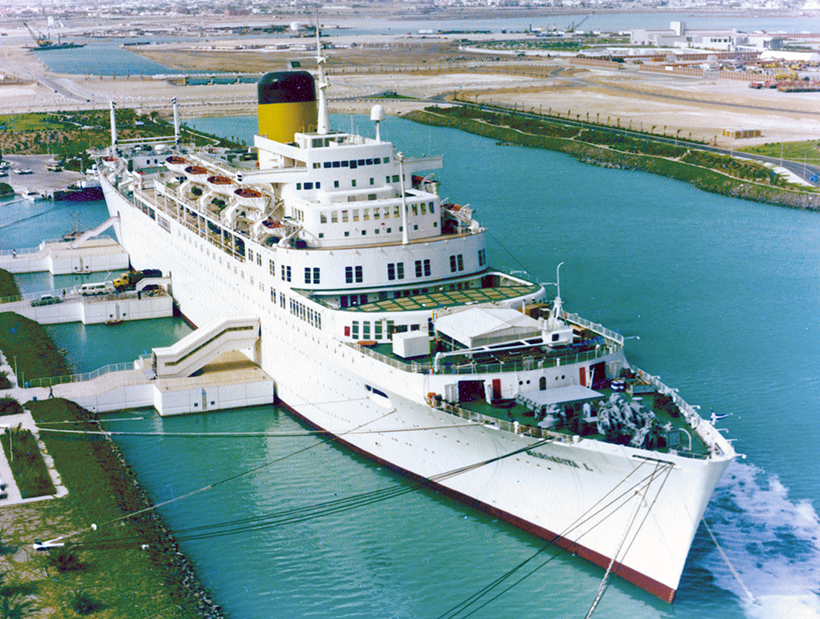
Margarita L looking resplendent in her role as an accommodation ship at Rabegh. (Pic: Peter Knego collection)
Wary of the weather deteriorating, I wanted to get the outer deck areas completed so we could concentrate on the interiors by the time the anticipated storm was in full swing. From the top of the house, I watched as Mike scaled the radio mast to get some spectacular photos overlooking both Margarita L and Marianna 9. After so many years in limbo, the green-painted decking was looking weathered, but the decay was still mostly cosmetic.
The first drops of rain began to fall while we were on the bridge wings. We worked our way down from there to the base of the funnel for views over the former First Class Lido and then further down, via the sheltered and open games deck areas to the fully encircling, teak-lined Boat Deck and the finite, sheltered promenades on Promenade Deck.
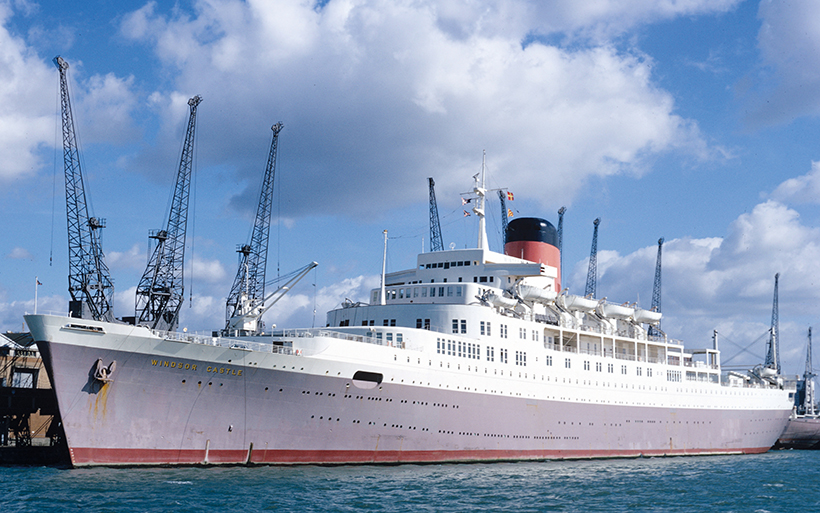
A stunning view of RMS Windsor Castle at Southampton, in October 1970. When completed in 1960, the new ship was notable for the high standard of her public rooms in a ‘traditional’ first class and ‘contemporary’ tourist class configuration. (Pic: Peter J Fitzpatrick)
From aft A Deck, we documented the weathered Tourist Class Lido, the Tourist Class Veranda Café and the Tourist Class Children’s Playroom with its built-in steamboat play area. Once at the fantail, we then worked our way forward to her fo’c’sle, where one of the original Windsor Castle bells still proudly remained.
With the generators providing additional light, we started our interior documentation at the wheelhouse, a museum-worthy space, with all of its original brass instruments and control panels. In the chart room there were diagrams and plans with RMS Windsor Castle stamped on them. In the captain’s quarters, where her Greek master waited as we continued our photographic pursuits, there were ornate plaster mouldings and rosewood furnishings. In the chief engineer’s cabin, I marvelled at some of the maple-framed furnishings and stacks of Union-Castle era log books and plans. I also noticed wool P&O blankets that had been de-stored from the former liners Strathmore and Stratheden (later Henrietta and Marianna Latsi), which were scrapped in the late 1960s.

Margarita L and Marianna 9 at Petrola, on 14th December, 1998.
The watchman with the keys to the First Class Lounge and Library was not on duty, so we had to wait until the following morning to access those spaces. However, the rest of the First Class rooms on the Promenade Deck were opened up for us, from the rebuilt Smoking Room on the port side to the still original Drawing Room, rotunda-shaped Writing Room and the rather odd Verandah Cafe, which opened onto the First Class Pool via a large wood and glass screen. This last space boasted a perplexing combination of original and brightly-coloured modern furnishings.
On A Deck, we visited the handsome Tourist Class Lounge with its windows facing the Tourist Class Games Deck and sporting a sunken dance floor in its centre. Melamine-topped, brass-framed tables featured three different bird motifs. The tables tied in with the miniature aviary, a scaled-down version of the Lin Tissot Murano glass aviary that was originally in the First Class Lounge.
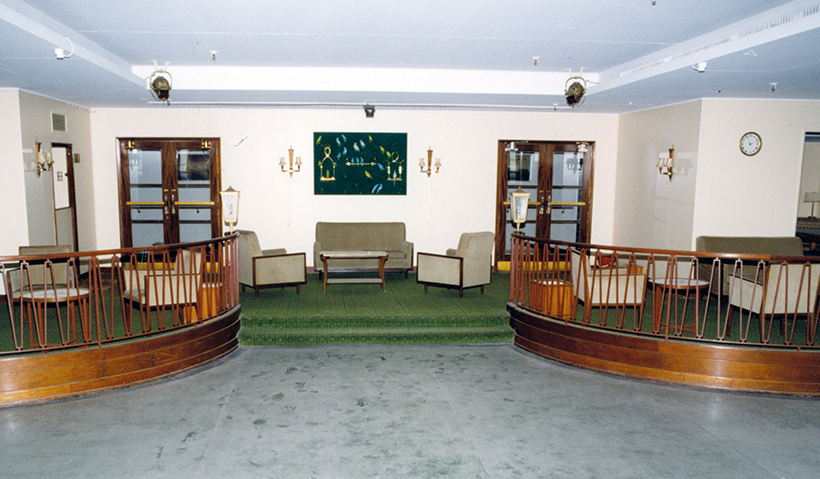
The former Tourist Class Lounge, in an aft-facing view, photographed in 1998.
Tourist Class public spaces continued aft on the port side, with the Library, Writing Room and the Tourist Class Smoking Room. This latter, rotunda-shaped space was most interesting, with its bronze centrepiece that resembled a combination of an astrolabe and a hookah, with the Camelopardalis constellation painted into the ceiling recess above. In each corner, there were ship models and, just aft, the Smoking Room bar area had a lounge with seating and a tavern-like bar with faux street lamps.
Meanwhile, the starboard portion of this deck was dedicated to the top 13 First Class suites, including the Almond Blossom, where we had stowed our belongings. These spacious staterooms had bedrooms and sitting areas, large windows and custom soft fittings that corresponded to their designated names, which included Peony, Red Rose and Golden Pheasant.
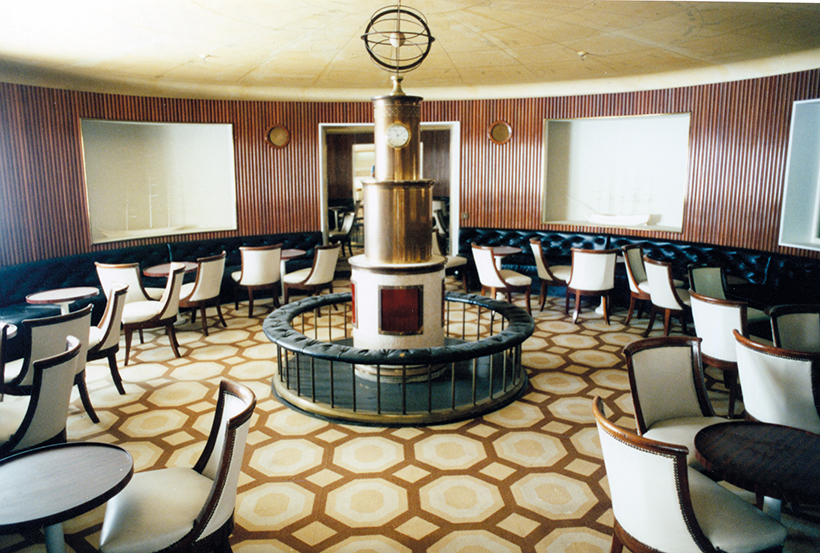
The Tourist Class Rotunda still boasted its original features, photographed in 1998.
On B Deck, we visited some former First Class cabins, which, aside from a bit of dust, were mostly made up and looked almost ready to receive guests. Farther aft, there were some Tourist Class cabins with multiple berths and a sink, with showers and toilets down the hall. The First Class Entrance was home to the Reception, a few shops and a beauty parlour. Further aft, there was also the Cinema.
At the bottom of the forward staircase on D Deck, the First Class Dining Room came to life with the flick of a light switch, revealing its original checkered linoleum decking, wooden furnishings and spindly chandeliers. A private dining room used for special events during the Union-Castle era, and for Mr Latsis’ private functions in later years, was accessed from the Dining Room’s port side.
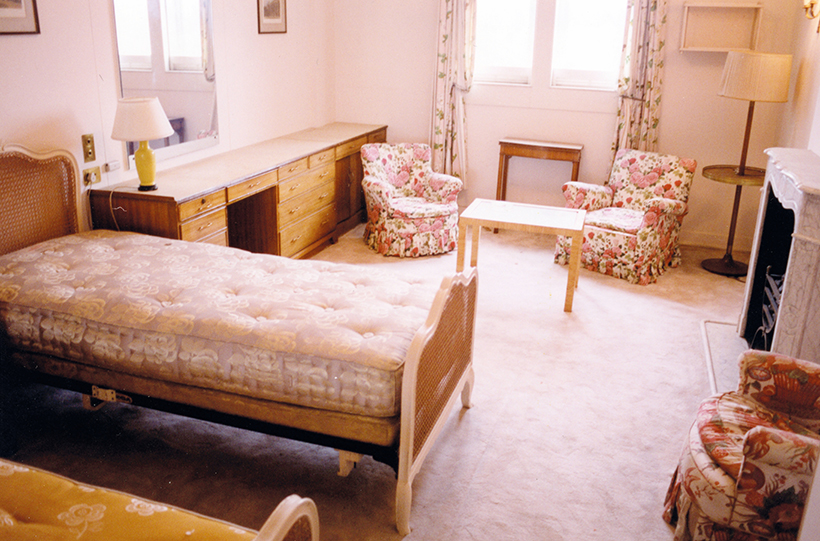
Most of the de luxe cabins on A Deck were still in their original configuration, photographed in 1998.
We worked our way aft through the galley to the Tourist Class Dining Room, which was also unaltered from its Union-Castle era. A large painting by British artist Sidney Smith dominated that room’s aft bulkhead. Depicting a Classical Roman scene in Dali-esque style, the painting was painstakingly restored in 1990 by an artist named Dario Faller. This was quite possibly the most important work of art on the ship. Our visit came to an end when the approaching tender blew its horn.
Early the following morning, we returned to Margarita L, first to visit the blandly rebuilt First Class Lounge, the Library and then the vast machinery spaces. The engine and boiler rooms, stabilisers and even the twin shaft areas were photographed before we crossed over a short jury-rigged gangway to Marianna 9, which we spent the next hours documenting.
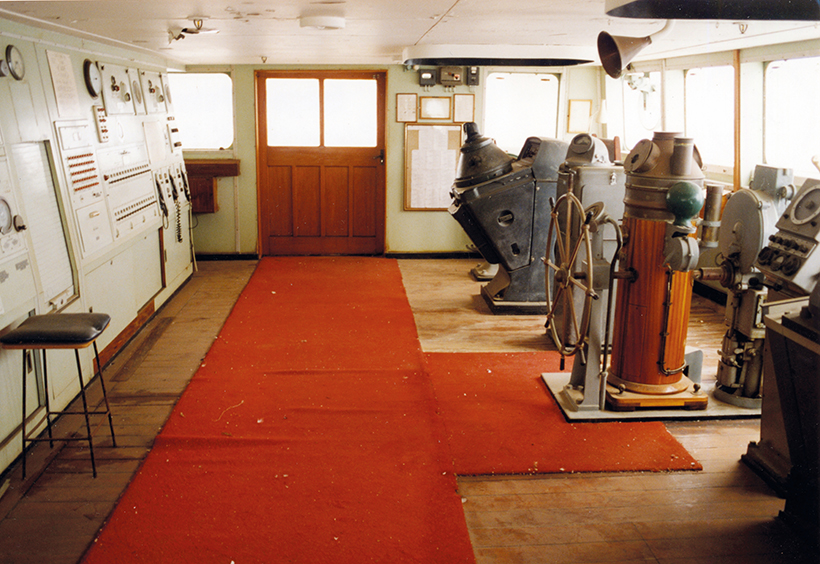
The wheelhouse was virtually unchanged from the Union-Castle era in 1998.
Broken dreams
When I returned to Margarita L three years later she was still languishing at Petrola but was now alone since Marianna 9 had departed for shipbreakers in India. In those three years, more decay had set in, and there was even some ingress of water and mould to her interior. She was still intact and well worth preserving but, unfortunately, a campaign to bring her back to the UK as a hotel ship went nowhere and, after another two years, in late 2004, she was sold for scrap.
With the delivery name Rita, the ship left Petrola under her own power in April 2005, but when scrap prices dropped drastically, she was ordered to anchor off Kalba in the UAE. When steel prices improved and it was time to sail to India, her engines could not be started, so a tug was called. With Rita under tow, the tug broke down and finally limped to the beach at Alang, where both vessels were driven ashore for scrapping in July 2005.
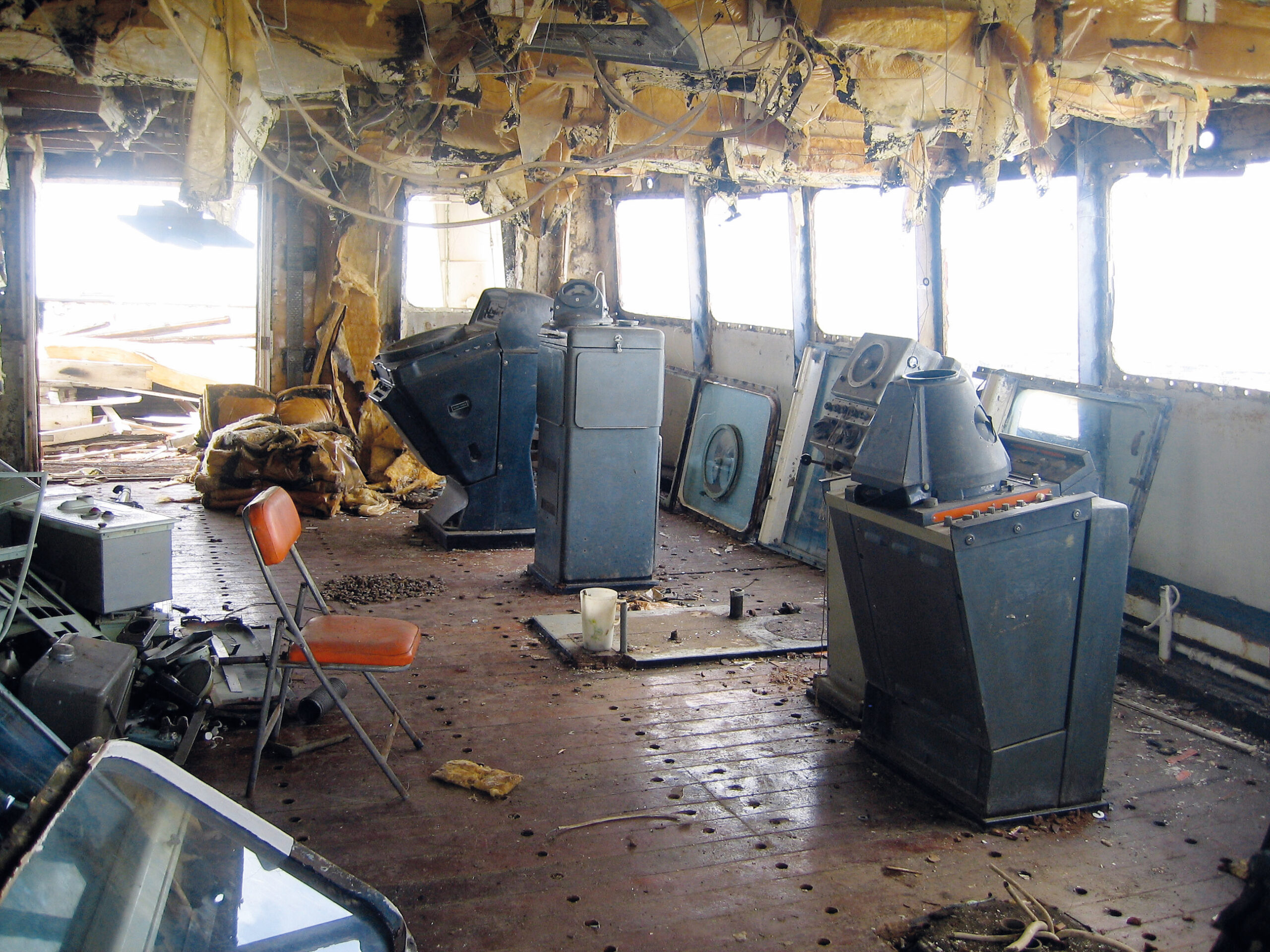
Rita’s stripped-out wheelhouse when the ship was being broken at Alang.
I made my third visit to Alang in September 2005 to rescue fittings and furnishings from Margarita L. When I arrived, the demolition was well under way, with her bow and stern missing and most of her interiors stripped. I spent an afternoon on board in search of anything that might have been left behind, thoroughly bewildered that this beautiful ship had remained so perfectly intact, only to be torn apart.
As workers pried away her teak decking and prepared a huge section of her aft/starboard hull to be cut down, I wandered her ravaged spaces in search of anything salvageable. Sadly, despite my efforts, the Sidney Smith painting in her Tourist Class Dining Room was scratched and was ultimately destroyed.

Rita shortly after arrival at Alang. (Pic: Kaushal Trivedi)
After an exhausting and desperately sad final visit, I headed ashore to see what was left in the breaker’s stores. Even more distressing were the many furnishings and items like light fixtures and bakelite telephones that were haphazardly covered under tarps that were no match for the monsoons that summer.
Almost everything was ruined by rain water or mould, but I did manage to extract a few treasures and filled a 40ft container with items obtained from the breaker and the local traders’ yards. Demolition proceeded ferociously and by January 2006, when that container of fittings arrived at my Southern California home, the former RMS Windsor Castle had ceased to exist.
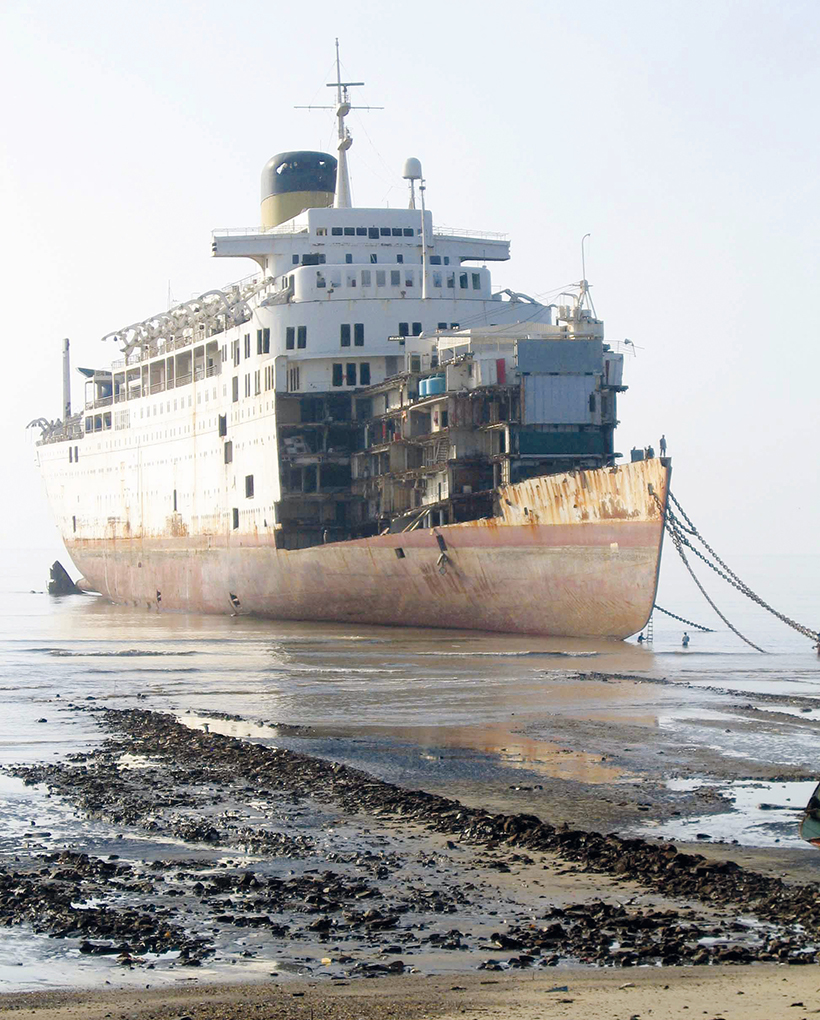
Latsis Lines sold Margarita L in December 2004 to an undisclosed party, with the view to disposing of the vessel to Indian scrap merchants. After some time was spent reactivating long idle main engines, the vessel sailed to India on 14th April, 2005, under the shortened name Rita. The ship’s last voyage under steam was from Piraeus, Greece, to Alang via Port Said, the Suez Canal and Aden. By September 2005, the demolition of Rita was well under way at Alang.
This feature comes from the latest issue of Ships Monthly, and you can get a money-saving subscription to this magazine simply by clicking HERE





